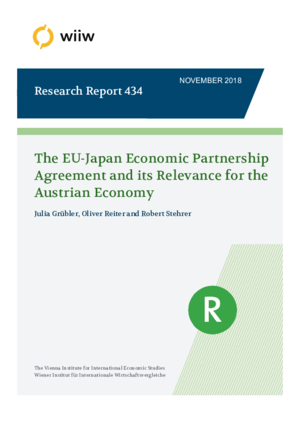The EU-Japan Economic Partnership Agreement and its Relevance for the Austrian Economy
Julia Grübler, Oliver Reiter and Robert Stehrer
wiiw Research Report No. 434, November 2018
39 pages including 5 Tables and 14 Figures
Since the beginning of 2017, a paradigm change in international trade policy is observed. While protectionist agendas are on the rise, the EU and Japan signed an Economic Partnership Agreement (EPA) on 17 July 2018. It is the EU’s most ambitious agreement with any Asian state. The study estimates the effect of the EU-Japan EPA for Austria based on qualitative analysis and a structural gravity model. The model predicts small but positive effects of around 0.01% of GDP for Austria. Highest gains are expected for manufactured goods, particularly in the medium- and high-tech sectors.
Abstract in German language
Seit Anfang des Jahres 2017 vollzieht sich in der internationalen Handelspolitik ein Paradigmenwechsel. Während protektionistische Agenden an Fahrt gewinnen, unterzeichneten die EU und Japan am 17. Juli 2018 ein Wirtschaftspartnerschaftsabkommen (EPA). Es ist das ambitionierteste Abkommen der EU mit einem asiatischen Staat. Die Studie schätzt die Effekte des EU-Japan-EPA für Österreich mithilfe von qualitativen Analysen und einem strukturellen Gravitationsmodell ab. Für Österreich wurde ein kleiner, aber positiver Effekt von rund 0,01% des BIP errechnet. Es wird erwartet, dass vor allem der Fertigungsbereich in Mittel- und High-Tech-Sektoren von diesem Abkommen profitieren wird.
Keywords: economic partnership, free trade, EPA, FTA, EU, Japan, JEFTA, South Korea, tariffs, non-tariff measures, structural gravity model
JEL classification: D58, F13, O24, Q17
Countries covered: Canada, European Union, Japan, South Korea, USA
Research Areas: International Trade, Competitiveness and FDI
